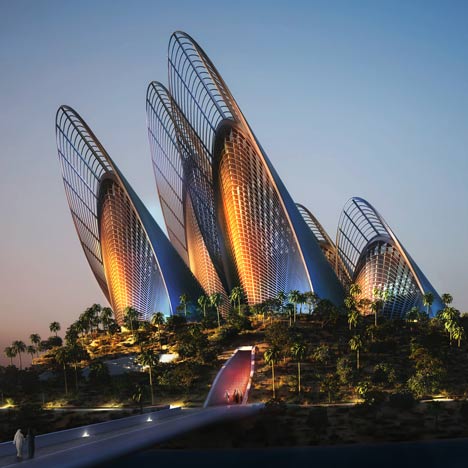Foster + Partners have unveiled designs for a museum on Saadiyat Island in Abu Dhabi.
The Zayed National Mueum will feature five lightweight steel towers resembling birds' wings, set within a landscaped mound with gallery spaces located at ground level.
The latticed towers will be designed to act as thermal chimneys that will draw cool air into the spaces below, whilst cooling pipes buried beneath will release fresh air into the lobby.
Named after UAE founder Sheikh Zayed bin Sultan Al Nahyan, the museum will be dedicated to the history and culture of the country.
The museum is the latest superstar-designed building to be unveiled for Saadiyat Island cultural district; a performing arts centre by Zaha Hadid, a Guggenheim by Frank Gehry, a branch of the Louvre museum by Jean Nouvel and a maritime museum by Tadao Ando are already underway.
See the Masdar Institute by Foster which was opened in Abu Dhabi two days ago in our earlier story.
The following information is from Foster + Partners:
Designs for Zayed National Museum in Abu Dhabi revealed
Designs for the Zayed National Museum have been officially unveiled today by His Highness Sheikh Mohammed bin Rashid Al Maktoum, Vice-President and Prime Minister of the UAE and Ruler of Dubai and Her Majesty Queen Elizabeth II of the United Kingdom. Conceived as a monument and memorial to the late Sheikh Zayed bin Sultan Al Nahyan, the founding president of the UAE, the Museum will be the centrepiece of the Saadiyat Island Cultural District and will showcase the history, culture and more recently the social and economic transformation of the Emirates.
Architecturally, the aim has been to combine a highly efficient, contemporary form with elements of traditional Arabic design and hospitality to create a museum that is sustainable, welcoming and culturally of its place. Celebrating Sheikh Zayed’s legacy and love of nature, the museum is set within a landscaped garden, based on a timeline of his life.
The display spaces are housed within a man-made, landscaped mound. The galleries are placed at the bases of five solar thermal towers. The towers heat up and act as thermal chimneys to draw cooling air currents naturally through the museum. Fresh air is captured at low level and drawn through buried ground-cooling pipes and then released into the museum’s lobby. The heat at the top of the towers works to draw the air up vertically through the galleries due to the thermal stack effect. Air vents open at the top of the wing-shaped towers taking advantage of the negative pressure on the lee of the wing profile to draw the hot air out.
Here in the museum these towers are lightweight steel structures, sculpted aerodynamically to work like the feathers of a bird’s wing. The analogies with falcons and flight are deliberate and relate directly to Sheikh Zayed’s love of falconry. This theme is further celebrated by a gallery devoted to the subject as part of a wider focus on conservation. These inner spaces open up to an outdoor arena for live displays with hunting birds.
Balancing the lightweight steel structures with a more monumental interior experience, the galleries are anchored by a dramatic top-lit central lobby, which is dug into the earth to exploit its thermal properties and brings together shops, cafes, an auditorium and informal venues for performances of poetry and dance. Throughout, the treatment of light and shade draws on a tradition of discreet, carefully positioned openings, which capture and direct the region’s intense sunlight to illuminate and animate these interior spaces. Objects are displayed within niches and on stone plinths that rise seamlessly from the floor.
The museum contains a variety of performance spaces. A large auditorium, lined with Emirati textiles, provides an evocative setting for presentations and films. The lobby incorporates more informal venues for poetry readings, music and dance, where the audience can gather in a circle to enjoy the spectacle and atmosphere of traditional performances.
The interior concept for the restaurant draws on the opulence and hospitality of the Bedouin tent, with carefully selected furnishings. The majlis, or VIP spaces, open onto a central courtyard. This traditional space offers guests a unique perspective, as it is the only place in the museum where one can enjoy views of the wind towers.
Lord Foster said: “It has been a great privilege to work on the Zayed National Museum, to carry forward Sheikh Zayed’s vision and to communicate the dynamic character of a contemporary United Arab Emirates. We have sought to establish a building that will be an exemplar of sustainable design, resonating with Sheikh Zayed’s love of nature and his wider heritage.”
See also:
.
| Gehry, Nouvel, Ando, Hadid build in Abu Dhabi | Jean Nouvel in Abu Dhabi |
Zaha Hadid in Abu Dhabi |

